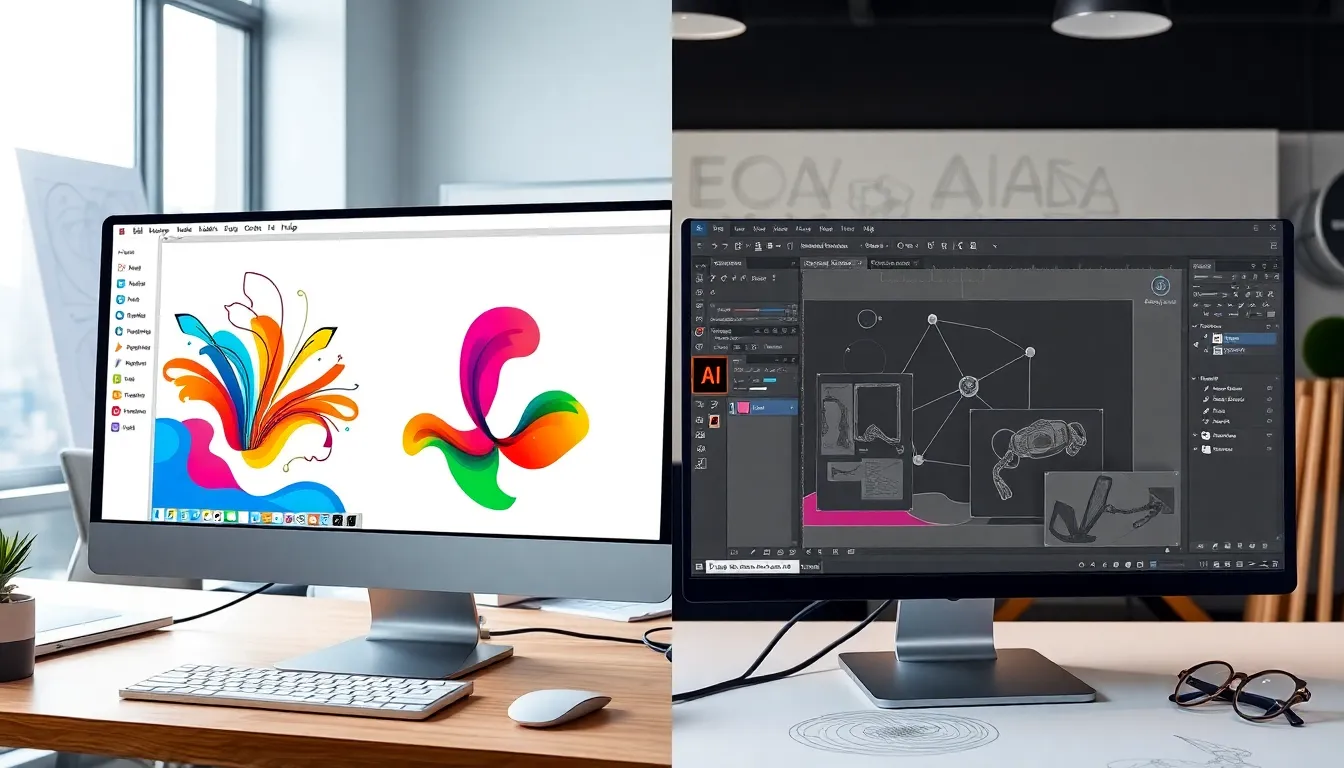When it comes to graphic design software, the battle between Inkscape and Illustrator is hotter than a jalapeño in a sauna. Both tools boast unique features and capabilities, but which one deserves a spot in your creative arsenal? Whether you’re a seasoned pro or just starting your design journey, choosing the right software can feel like picking between a luxury sports car and a trusty old bicycle.
Inkscape, the free and open-source darling of the design world, offers a plethora of features that might just make your wallet breathe a sigh of relief. On the other hand, Adobe Illustrator stands tall as the industry standard, packed with tools that could make even a potato look like a masterpiece. Buckle up as we dive into the quirks and perks of these two heavyweights, helping you decide which one will take your design game to the next level.
Table of Contents
ToggleInkscape VS Illustrator
Inkscape and Adobe Illustrator offer unique advantages in graphic design. These tools cater to different needs and preferences among users.
Key Features of Inkscape
Inkscape provides a robust open-source platform for vector graphic design. Users benefit from its extensive support for various file formats, including SVG and PDF. A wide range of drawing tools allows for precise creativity. Customizable interface options enhance the user experience. Community-driven plugins expand functionality, offering additional creative capabilities. Regular updates improve stability and introduce new features to meet evolving design demands.
Key Features of Illustrator
Adobe Illustrator stands out with advanced vector graphics capabilities. Professional artists appreciate its precision drawing tools like the Pen tool and Shape Builder. Integration with other Adobe products streamlines workflows significantly. Extensive type manipulation options allow for captivating typography. Graphic styles and effects enable intricate design possibilities that elevate projects. Regular updates enhance performance and introduce innovative features, remaining a top choice in the industry.
User Interface Comparison

Both Inkscape and Adobe Illustrator feature distinctive user interfaces that cater to different preferences. Each software prioritizes functionality while offering unique visual experiences.
Customization Options
Inkscape supports extensive customization options, allowing users to alter menus, toolbars, and workspace layouts. Users can personalize their environment based on specific design needs. A variety of themes is available, providing further flexibility in aesthetics. Illustrator also excels in customization, permitting adjustments to panels and workspace configurations. Designers can save customized workspaces tailored to their workflow. This level of personalization empowers users to enhance productivity.
Ease of Use
Inkscape presents an intuitive interface suitable for beginners and experienced users alike. Many find its learning curve manageable, with straightforward access to tools and menus. Tutorials and community resources facilitate the learning process. Conversely, Illustrator boasts a more complex interface that may overwhelm novices. Experienced users appreciate its advanced features and precision tools which allow for detailed work. With practice, both software options can become user-friendly for diverse skill levels.
Performance and Compatibility
Performance and compatibility play crucial roles when choosing between Inkscape and Adobe Illustrator. Each software exhibits strengths that cater to different user needs.
File Format Support
Inkscape supports multiple file formats, including SVG, PDF, EPS, and PNG, making it versatile for various projects. Users can easily import and export files, promoting workflow efficiency. Adobe Illustrator also excels in file format support, handling formats like AI, SVG, PDF, and raster images. Compatibility with other Adobe products streamlines collaborative efforts, enhancing the user experience.
System Requirements
Inkscape runs well on a broad range of systems, requiring minimal resources. A modest setup with 2 GB of RAM and a dual-core processor suffices for smooth operation. In contrast, Adobe Illustrator demands higher specifications, typically requiring at least 8 GB of RAM and a multi-core processor for optimal performance. Users with powerful systems often experience improved processing speed and responsiveness when working on complex graphics in Illustrator.
Pricing and Value
Understanding the pricing and value of Inkscape and Adobe Illustrator helps users make informed decisions. Inkscape presents a cost-effective solution with its free and open-source model, enabling users to access all features without any financial commitment. Users can download and install it on various operating systems, including Windows, macOS, and Linux. The absence of subscription fees and hidden costs adds to its appeal, particularly for beginners or those on a budget. Donations can support ongoing development if users wish to contribute.
Adobe Illustrator operates under a subscription-based pricing model, which typically involves monthly or annual fees. Regularly, Adobe offers various plans, including individual, business, and student discounts. An individual subscription starts around $20.99 per month, providing access to the latest features and updates. Businesses may prefer annual plans, which drop the monthly rate slightly. While it’s a higher financial investment, users receive premium tools and advanced support, enhancing their overall design experience.
Conclusion
Choosing between Inkscape and Adobe Illustrator ultimately depends on individual needs and preferences. Inkscape stands out as a powerful and cost-effective option for those seeking a free tool with solid capabilities. Its user-friendly interface and extensive customization options make it accessible for beginners and appealing for experienced designers alike.
On the other hand, Adobe Illustrator remains the go-to choice for professionals who require advanced features and seamless integration with other Adobe products. Its precision tools and robust design capabilities cater to those looking to push creative boundaries.
Whether one opts for the open-source flexibility of Inkscape or the premium offerings of Illustrator, both programs provide valuable resources for graphic design. The right choice will align with specific project requirements and personal workflow preferences.
